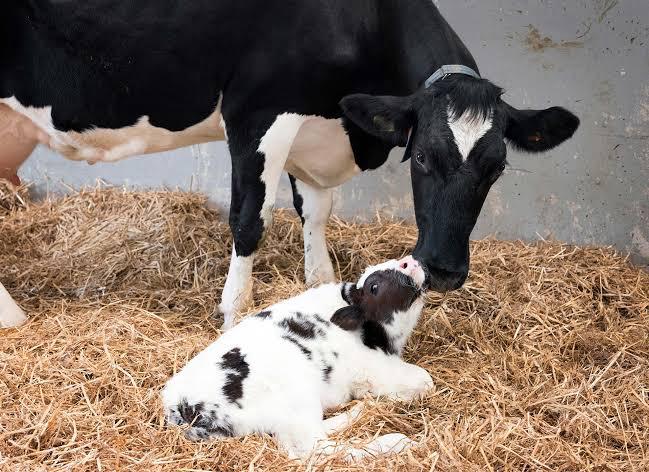
Agric4Profits – Explores the importance of balanced diets for ruminant animals, detailing the roles of proteins, carbohydrates, and fiber in cattle nutrition
A balanced diet is crucial for the health, growth, and productivity of ruminant animals like cattle. Proteins, carbohydrates, and fiber play distinct yet interconnected roles in optimizing cattle nutrition. While proteins support growth and immune function, carbohydrates provide energy, and fiber ensures proper rumen health and digestion. Achieving the right balance among these nutrients is key to maximizing productivity and farm profitability in livestock operations.
🐶 Pet Star
46 min read · 17, Apr 2025

Agric4Profits – Exploring the Importance of Balanced Diets for Ruminant Animals: The Role of Proteins, Carbohydrates, and Fiber in Cattle Nutrition
In the world of livestock farming, nutrition is the backbone of productivity, animal health, and overall farm profitability. Ruminant animals, such as cattle, sheep, and goats, possess a unique digestive system that enables them to utilize fibrous plant materials that monogastric animals (like pigs and poultry) cannot efficiently digest. However, even with this remarkable adaptation, the significance of a balanced diet cannot be overstated.
This article, presented under the Agric4Profits initiative, delves deeply into why a well-rounded dietary plan is vital for ruminant animals—focusing on cattle as the primary species—and how proteins, carbohydrates, and fiber interact to ensure optimal health, growth, and productivity.
Understanding the Ruminant Digestive System
To appreciate the importance of balanced diets in ruminants, it's essential to understand their digestive anatomy. Ruminants have a four-compartment stomach: the rumen, reticulum, omasum, and abomasum.
- Rumen: The largest compartment where microbial fermentation occurs.
- Reticulum: Works closely with the rumen in moving and filtering food particles.
- Omasum: Absorbs water and nutrients from digested feed.
- Abomasum: The "true stomach" where enzymatic digestion takes place.
This unique system allows ruminants to ferment fibrous feeds like grasses and convert them into energy, microbial protein, and other essential nutrients.
The Need for a Balanced Diet in Ruminants
Balanced nutrition is critical for:
- Growth and development
- Reproductive efficiency
- Milk and meat production
- Immune function and disease resistance
- Efficient feed utilization and profitability
A diet that lacks balance can lead to poor performance, illness, reproductive failure, and economic loss.
Let’s examine the three pillars of ruminant nutrition: proteins, carbohydrates, and fiber.
1. Proteins – The Building Blocks of Life
Role in Ruminant Nutrition
Protein is crucial for muscle development, milk production, immune response, and enzyme/hormone synthesis.
- Microbial protein production: Ruminants rely heavily on microbial protein produced in the rumen.
- Essential amino acids: Required for bodily functions and must be supplied either via diet or microbial synthesis.
- Tissue repair and growth: Especially critical in young, growing calves and lactating cows.
Sources of Protein in Cattle Diets
- Legumes (e.g., alfalfa, clover)
- Oilseed meals (soybean meal, cottonseed meal)
- Urea and other non-protein nitrogen sources (used cautiously)
- Silage and green fodder
Balancing Protein Intake
Too little protein results in poor growth and reproductive problems. Too much leads to excessive nitrogen excretion, environmental pollution, and increased feed costs.
Optimal crude protein content in a cattle diet typically ranges between 12% to 16%, depending on the production stage.
2. Carbohydrates – The Primary Energy Source
Function in the Ruminant Diet
Carbohydrates serve as the primary energy providers for ruminants. They fuel:
- Fermentation processes in the rumen
- Maintenance metabolism
- Reproductive activity
- Lactation and muscle activity
Types of Carbohydrates
- Structural carbohydrates (fiber – cellulose and hemicellulose)
- Found in forages and crop residues.
- Degraded by microbes in the rumen.
- Non-structural carbohydrates (sugars and starches)
- Found in grains like corn, barley, and sorghum.
- Fermented quickly and provide a rapid energy boost.
Balancing Energy Intake
Excessive rapidly fermentable carbohydrates can lead to ruminal acidosis, while deficiency results in low milk yield, poor growth, and fertility issues.
Energy requirements vary:
- Lactating cows need more energy than dry cows.
- Finishing cattle (meat production) require more grains.
- Maintenance diets focus more on fibrous, slower-digesting carbs.
3. Fiber – The Cornerstone of Rumen Health
Importance of Fiber
Fiber isn't just filler—it plays a vital role in rumen function and health. It:
- Stimulates saliva production, which buffers rumen pH.
- Promotes rumination (chewing cud).
- Maintains healthy microbial populations.
- Prevents digestive disorders like bloat and acidosis.
Types of Fiber
- Neutral Detergent Fiber (NDF): Reflects the total fiber in the diet. Higher NDF means slower digestion.
- Acid Detergent Fiber (ADF): Indicates fiber less digestible to rumen microbes.
Fiber Sources
- Pasture and hay
- Silage
- Straws and crop residues
A proper diet should include at least 25-30% NDF (on dry matter basis) to ensure proper rumen function.
Balancing the Nutrients: The Art and Science
Achieving the right balance among proteins, carbohydrates, and fiber is both an art and science. Each animal has unique needs based on:
- Age
- Physiological status (pregnant, lactating, growing)
- Breed
- Environmental factors
Common Feed Formulation Techniques
- Least-cost ration formulation
- Nutrient requirement tables (e.g., NRC guidelines)
- Use of Total Mixed Ration (TMR) to ensure uniformity
Veterinarians and animal nutritionists often use ration balancing software and real-time monitoring to ensure optimal feeding programs.
Consequences of Nutritional Imbalance
An imbalance can result in:
- Low productivity
- Reproductive failure
- Metabolic diseases (ketosis, acidosis, bloat)
- Poor feed efficiency
- High mortality in severe cases
Therefore, proactive diet management is not just good practice—it's essential.
The Importance of Balanced Diets for Ruminant Animals: Proteins, Carbohydrates, and Fiber in Cattle Nutrition
Balanced nutrition is the foundation of optimal health, growth, and productivity for ruminant animals like cattle, and understanding the roles of essential nutrients such as proteins, carbohydrates, and fiber is crucial for effective management of livestock diets. Cattle, as ruminants, possess a unique four-compartment stomach designed to break down fibrous plant material through a process of fermentation, allowing them to derive nutrients from sources that other animals cannot efficiently digest. However, the proper balance of proteins, carbohydrates, and fiber is critical for ensuring that these nutrients are effectively utilized to promote the animal's health and productivity. Proteins, in particular, are the building blocks of life, essential for tissue repair, growth, and the production of hormones and enzymes that regulate various bodily functions. In ruminants, protein serves not only as a direct source of amino acids for the animal’s needs but also contributes to the development of microbial populations in the rumen, which assist in the breakdown of complex carbohydrates like cellulose. While cattle can synthesize some amino acids, others must be supplied through their diet, making it essential for farmers to provide high-quality protein sources such as alfalfa, soybean meal, and certain oilseed meals. However, protein content in cattle diets must be carefully managed, as excess protein can lead to nitrogen excretion into the environment, increasing feed costs without corresponding benefits, and potentially contributing to environmental pollution. A balance of crude protein in the range of 12% to 16% is generally recommended for most cattle, although specific requirements may vary depending on the animal's age, weight, production stage (whether the animal is lactating, growing, or pregnant), and the type of feed available. Too little protein can result in stunted growth, decreased milk yield, reproductive inefficiency, and a weakened immune system, which can make the animals more susceptible to diseases. In contrast, an excess of protein can be inefficient and economically detrimental, leading to higher feed costs and increased waste management issues. Complementing protein, carbohydrates serve as the primary energy source in cattle diets, fueling everything from basic metabolic functions to more energy-intensive processes such as lactation and growth. Carbohydrates are divided into two broad categories: structural carbohydrates, which are found in the fiber of plant cell walls, and non-structural carbohydrates, which are more readily digestible, such as starches and sugars found in grains. The rumen is designed to ferment fiber and break it down into volatile fatty acids (VFAs), which are then absorbed and used as a primary energy source. Fiber is essential not only for providing energy but also for maintaining healthy rumen function. Inadequate fiber in the diet can lead to a reduction in rumen motility, a decrease in cud chewing, and insufficient saliva production, all of which are essential for maintaining an optimal rumen pH and promoting efficient fermentation. When rumen fermentation is disrupted, it can lead to metabolic disorders such as acidosis, where the rumen’s pH becomes too acidic, impairing digestion and causing discomfort or illness in the animals. Fiber also plays a critical role in stimulating the production of saliva, which helps buffer the rumen’s acid levels and provides the necessary environment for microbes to thrive. Fiber content is usually measured in terms of Neutral Detergent Fiber (NDF), which reflects the total fiber in the diet, including both digestible and indigestible parts, and Acid Detergent Fiber (ADF), which measures the fiber that is less digestible. A diet with a balanced NDF content, typically ranging between 25% to 30% of dry matter, ensures that cattle can maintain healthy rumen function, and aids in the proper digestion of both structural and non-structural carbohydrates. On the other hand, carbohydrates such as starch and sugars found in grains provide a faster source of energy but should be fed in moderation to prevent ruminal acidosis and digestive upset. The careful management of fiber and carbohydrate intake is essential for optimizing feed efficiency, growth, and overall health. Furthermore, the proper balance between proteins, carbohydrates, and fiber helps cattle make the most efficient use of the feed, improving their growth rates, reproductive performance, and milk production. In practical terms, achieving this balance often involves the use of Total Mixed Ration (TMR) feeding systems, where all the nutrients—proteins, carbohydrates, and fiber—are mixed together in specific proportions to ensure that every bite consumed by the animal is nutritionally complete. Using TMR or other balanced feeding approaches ensures that cattle receive all the nutrients they need in each meal, which promotes better health, more consistent production, and higher profitability for farmers. However, it’s important to note that dietary requirements will vary depending on factors such as age, weight, and specific production goals. For instance, lactating cows have higher energy requirements than dry cows, and growing calves require more protein to support their development. Additionally, environmental factors, such as weather conditions or the quality of available forage, can also affect the nutritional needs of cattle. For example, in periods of drought or during winter months, supplemental feeding may be necessary to ensure that the cattle receive adequate nutrition. This is where the expertise of nutritionists and veterinarians comes into play, helping farmers design and adjust feeding programs that meet the evolving nutritional needs of their livestock. Effective nutritional management also plays a key role in disease prevention, as well-fed cattle are more likely to have strong immune systems, making them less susceptible to infections and other health issues. In conclusion, the interplay of proteins, carbohydrates, and fiber in cattle nutrition is crucial for ensuring that these animals remain healthy, productive, and economically viable. By providing cattle with a well-balanced diet tailored to their specific needs, farmers can optimize growth, milk production, and reproduction, while minimizing feed waste and environmental impact. With the right balance of these key nutrients, farmers can maximize their return on investment, improve sustainability, and contribute to the overall efficiency of the agricultural sector. In essence, nutrition is not only about feeding cattle but about strategically nourishing them to ensure they perform at their best, yielding the highest possible returns for the farmer and the broader agricultural community.
The Critical Role of Balanced Diets in Ruminant Nutrition: The Interplay of Proteins, Carbohydrates, and Fiber in Cattle Health and Productivity
In the ever-evolving landscape of livestock production, one principle remains universally consistent: nutrition is the cornerstone of animal health, productivity, and farm profitability. This is particularly true for ruminant animals like cattle, whose unique four-chambered digestive systems—comprising the rumen, reticulum, omasum, and abomasum—equip them to break down complex fibrous plant materials into valuable nutrients. Despite this remarkable biological adaptation, cattle still require a carefully balanced diet to thrive, perform optimally, and reach their genetic potential. At the heart of this dietary balance lie three major nutritional components—proteins, carbohydrates, and fiber—each playing indispensable roles in sustaining life processes, promoting efficient digestion, and supporting the production of milk, meat, and reproductive success. Proteins, often referred to as the building blocks of life, are vital for tissue growth, muscle development, enzyme synthesis, and immune function. In ruminants, protein also supports the proliferation of rumen microbes, which are instrumental in breaking down fibrous feeds and synthesizing microbial protein—a critical source of essential amino acids for the host animal. Protein deficiency in a cattle diet can result in stunted growth, reproductive inefficiency, decreased milk yield, and increased vulnerability to disease, whereas excess protein leads to nitrogen wastage and environmental pollution. Hence, maintaining protein levels within optimal ranges (typically 12% to 16% crude protein in dry matter) depending on the animal's life stage is vital for sustainable and profitable farming. Complementing protein is carbohydrate, the primary source of energy in cattle diets, fueling every cellular activity from basal metabolism and thermoregulation to growth, reproduction, and lactation. Carbohydrates are broadly classified into structural carbohydrates—mainly cellulose and hemicellulose found in forages—and non-structural carbohydrates, like sugars and starches present in grains such as maize and sorghum. While the latter provide rapid energy through fast rumen fermentation, the former are fermented more slowly, ensuring a steady energy supply and helping maintain rumen stability. A well-balanced diet must include an appropriate mix of both types, avoiding extremes that can lead to metabolic disorders such as ruminal acidosis—a condition triggered by rapid fermentation of excess starches and characterized by low rumen pH, inflammation, and compromised feed intake. Carbohydrates also interact synergistically with proteins; energy from carbohydrates is essential for the effective utilization of dietary nitrogen by rumen microbes, reinforcing the importance of a holistic feeding strategy rather than focusing on nutrients in isolation. However, no discussion of ruminant nutrition is complete without a thorough examination of fiber, which is more than just roughage—it is the cornerstone of rumen function and overall digestive health. Adequate dietary fiber, particularly Neutral Detergent Fiber (NDF), stimulates cud-chewing and saliva production, both of which help buffer rumen acidity and prevent pH-related disorders. Fiber also physically stimulates the rumen lining, promoting motility and nutrient absorption, and provides a habitat for a diverse microbial population essential to breaking down cellulose into volatile fatty acids (VFAs), a key energy source for ruminants. Importantly, the balance of fiber must be carefully managed; while too little can result in poor rumen function and health problems, too much indigestible fiber can reduce feed efficiency and limit energy availability. Ideal fiber content often falls in the range of 25% to 30% NDF on a dry matter basis, though precise requirements may vary based on the breed, age, productivity stage, and environmental conditions. Bringing these components together into a nutritionally complete diet requires scientific precision, experience, and regular monitoring. Factors such as the cow’s physiological state (e.g., lactating, pregnant, or growing), environmental stressors (like heat or cold), forage availability, and production goals must be taken into account. Tools like ration balancing software, Total Mixed Ration (TMR) methods, and guidelines from institutions such as the National Research Council (NRC) help farmers and nutritionists design optimal feeding programs. Furthermore, practical application of balanced feeding promotes not only higher milk and meat yields but also improves feed conversion ratios (FCR), reduces veterinary costs, and minimizes the environmental impact of livestock production by curbing nutrient excretion. A well-fed cow is not only a productive cow but also a healthier, longer-living one that contributes positively to the sustainability of the farm system. In the context of Agric4Profits—a platform committed to sharing knowledge that drives agricultural success—understanding and implementing the principles of balanced ruminant diets is fundamental. Investing in the right nutrition is not just a cost; it is a long-term investment into animal welfare, farm economics, and food security. As global demand for animal protein continues to rise, sustainable livestock practices anchored in optimal nutrition will play a pivotal role in meeting future food needs. Therefore, balanced feeding in ruminants is not just a technical necessity—it is a strategic imperative for every forward-thinking livestock farmer.
Summary and Conclusions
Balanced diets in ruminants, particularly cattle, form the foundation of productive and profitable livestock farming. Understanding and managing the delicate interplay between proteins, carbohydrates, and fiber is critical.
- Proteins help in growth, milk production, and immunity.
- Carbohydrates provide the energy needed for all metabolic processes.
- Fiber maintains digestive health and rumen functionality.
With precision nutrition and a holistic approach, farmers can maximize yields, improve animal welfare, and reduce environmental impact. Agric4Profits emphasizes that feeding cattle isn't just about filling the stomach—it's about feeding for performance, sustainability, and profitability.
Q&A Section
Q1: - Why is protein essential in cattle diets?
Ans: - Protein is crucial for muscle development, reproduction, milk production, and maintaining a strong immune system. In ruminants, it also supports microbial growth in the rumen which helps digest fibrous feeds.
Q2: - What are the best sources of energy for ruminant animals?
Ans: - Carbohydrates are the main energy source, with grains like corn and barley providing quick energy, while forages provide sustained energy through fiber fermentation.
Q3: - How does fiber benefit the digestive system of cattle?
Ans: - Fiber aids rumen function, promotes saliva production, supports microbial health, and helps prevent digestive issues like bloat and acidosis.
Q4: - Can cattle diets have too much protein?
Ans: - Yes. Excess protein can lead to nitrogen waste, pollute the environment, and increase feeding costs without added benefits.
Q5: - What is a Total Mixed Ration (TMR)?
Ans: - TMR is a method of feeding where all dietary components (forages, grains, protein supplements, minerals) are mixed thoroughly to ensure consistent nutrient intake in every bite.
Similar Articles
Find more relatable content in similar Articles

Pets and Mental Health: The Science Behind Emotional H..
Discover the profound impact o.. Read More

Virtual Vet Visits: Are Online Consultations Reliable?..
As pet healthcare embraces dig.. Read More

Composting Pet Waste: A Greener Way to Clean Up...
As pet ownership continues to .. Read More

Social Media for Pets: Turning Your Pet into a Digital..
From playful puppies to charis.. Read More
Explore Other Categories
© 2024 Copyrights by rPets. All Rights Reserved.